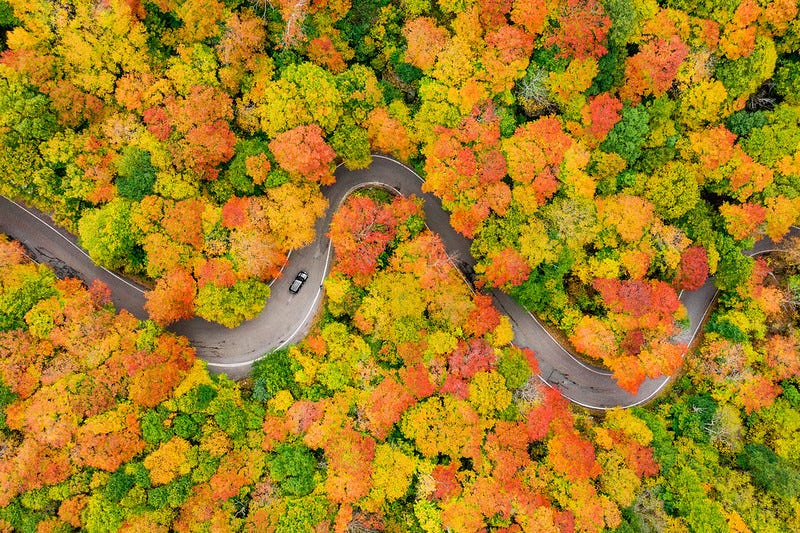We’re a few weeks away from peak leaf-peeping season here in the mid-Atlantic, but I’m seeing images from up North to remind me that the glory of chlorophyll breakdown is heading my way.

I look forward to this moment the way I anticipate a reunion with old friends. So great to see you, crimson and gold; been a minute! Ooh, do I spy amber over there? Seems russet and mulberry are back together – such a fun pair! Gotta say, you all look gorgeous in this light. Let’s turn up the music and celebrate!

As predictable as a hangover, though, is the massive leaf drop that follows. If those gray skies and bare branches weren’t depressing enough, there’s the prospect of all that raking. For many of us, anticipation of this chore casts a pall over our enjoyment of the season.
Guess what, though? You. Don’t. Have. To. Rake. In fact, it’s much better all around if you don’t. Fallen leaves are nature’s secret weapon. We can unleash their power by just letting them be. Seriously. Your goal should be to keep all your leaves on your property.

I’m not sure I can do justice to the value of fallen leaves, but here are a few of the benefits they provide:
When leaves decompose, they return rich layers of organic nutrients to the soil. They in fact create the specific soil chemistry and fertility that the plants they came from require.
The organisms that break down and consume leaves, including fungi, insects and other arthropods, are critical parts of the food webs that ultimately support birds, mammals and humans.
Leaf litter insulates the ground, protecting the roots of shrubs and trees from freezing weather.
A blanket of leaves works as well as any store-bought mulch in retaining moisture and suppressing weeds, in some cases including invasives.
Leaves capture rainwater, helping it infiltrate the soil rather than causing erosion and adding to stormwater runoff.
“The water from a 2-inch downpour, for example – more than 54,000 gallons per acre – is captured almost entirely by an oak forest’s leaf litter and the organic humus it creates…[they] corral it on-site just long enough for it to seep into the ground, replenishing the water table on which so many of us depend. In areas with no leaf litter, the same 2-inch rainstorm causes a flood.” — Doug Tallamy
Toads, turtles, songbirds, mammals and other critters use tree and plant debris for food and shelter.
Many moths, butterflies and bees overwinter in leaf litter. Great spangled fritillary and wooly bear caterpillars tuck themselves into a pile of leaves for protection from cold weather and predators. Red-banded hairstreaks lay their eggs on fallen oak leaves, which become the first food those caterpillars eat when they emerge. Luna moths and swallowtail butterflies disguise their cocoons as dried leaves, blending in with their surroundings. Bumble bee queens burrow an inch or two into the earth to hibernate for winter. A layer of leaves protects them from the elements. If you want to see pollinators next spring, protect their habitats this fall.

When I think about it, our old fall habits were kinda nuts. My husband and I would spend hours – days – scooping leaves into bags to be carted away like so much trash. Then come spring, we’d spend a small fortune, and risk more backaches, buying commercially-packaged compost, mulch and god knows what other elixirs to “enhance” our soil. Sound familiar? We were throwing away diamonds and replacing them with (expensive) rhinestones. What was up with that?
I’m a bit of a neatnik. I get that leaves not attached to trees seem messy. Particularly to those of us who’ve spent our entire lives believing we had a civic duty to remove all evidence of fall from our yards. So. What we did last year was to rake up leaves from our patios, paths, driveway and lawn (which we’re shrinking, I promise). We simply threw those fellas under trees and onto garden beds. No leaves left the premises. Aesthetic order was restored. Hours were saved. And our plants and critters benefited. Win, win, win, win.
I know other folks who use the business-up-front, party-in-the-back “mullet strategy.” They tidy and trim their street-facing yard as though it’s the 1950s. Behind the house, though, they let their leafy freak flag fly.
Find the ‘do that works for you.
Whole leaves are best because of the habitat they provide. But if you have so many they’d smother your trees, shrubs and perennials, try shredding some with a mower and stashing them in a pile in an out-of-the way corner. Down the road, when they’ve broken down some, you can add them back to your soil.

Bottom line: revel in the foliar spectacle with zero foreboding. You have The Bees’ Knees’ permission -- not just permission, encouragement -- to forsake that rake and leave the leaves!
Talk of mullets got me thinking about Chrissie Hynde and The Pretenders. Turns out, this is exactly the song I’d choose to kick off a reunion with old friends:
Resources
Scott Hoffman Black, “Leave the Leaves to Benefit Wildlife,” Xerces Society, November 12, 2020.
Meredith Gallogly and Claudia Thompson, “Leaving Your Leaves,” Grow Native Massachusetts, November 2015.
Douglas W. Tallamy, The Nature of Oaks, Timber Press, Portland, OR, 2021.
Laura Tangley, “Why You Should Leave the Leaves,” The National Wildlife Federation, October 1, 2015.
Justin Wheeler, “Leave the Leaves!” Xerces Society, October 6, 2017.




